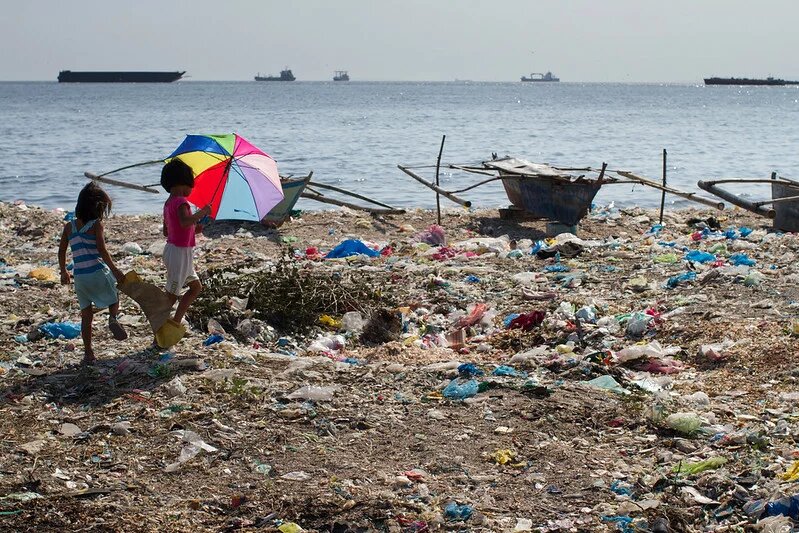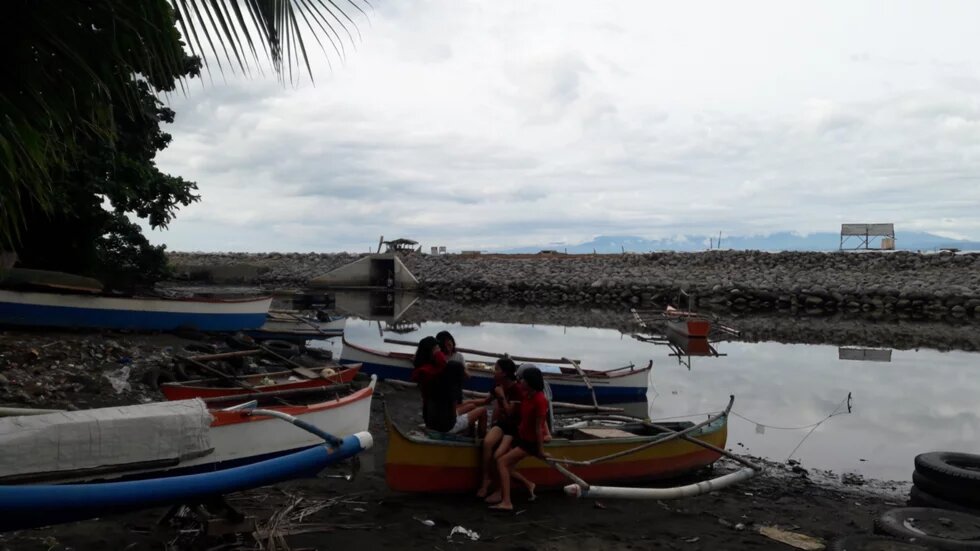
In a coastal city in the Philippines, poor families in the urban margins participate in the efforts to stem the effects of climate change, yet they are still likely to bear its worst effects. This piece explains why “segregation at source” measures that target households is not enough to stem the tide of plastic wastes.

Southeast Asia endured a brutal heatwave in the first half of 2024 with record breaking temperatures reaching as high as 53°C, classified as “extreme danger”. Philippine schools were forced to suspend classes, massive damage was recorded in its vital agricultural sector, and hundreds of deaths were reported across the region. The extreme heat left no doubt that global warming is indeed a deadly phenomenon, making our earth uninhabitable.
While scientists were troubled by the heatwaves and “record-shattering temperatures”, the consensus is that the extreme heat felt in the region is “within the realms of what the world can expect as global temperatures continue to rise rapidly”. Philippine scientists further noted that the heatwave would have been impossible without human-caused climate change.
The wet season may have brought relief from the scorching heat but abundant rain waters also bring problems of its own, with more plastic wastes entering the ocean during this season. Studies confirm that significant amount of accumulated plastic wastes washed off into the ocean increases by two to three times during the rainy season.
This should be a cause of concern because plastic pollution is known to “accelerate global warming and climate change”. Owing to its rapid urbanization and increasing middle class, yet inadequate infrastructure for waste management, Southeast Asia is emerging as a global hotspot in plastic pollution.
Plastic emissions at the household level
This article sheds light on how plastic emissions is taking place at the community level in the Philippines. The country is at the top of the list of largest contributors of plastic wastes to the ocean, with 466 of its rivers dumping 356,371 metric tons of plastic wastes per year into the oceans. Pasig river holds the notoriety as the world's most polluting river, accounting for 63,000 tons of plastic wastes entering per year. Aside from Pasig, 17 rivers in the Philippines appears in the top 50 plastic emitting rivers.
In 2019, Xavier University, conducted an audit of the marine debris in the shorelines of a coastal community in my hometown, Cagayan de Oro. The Cagayan de Oro River, which flows through the city, is ranked 32nd in the top 50 plastic-emitting rivers in the world. The study aimed to assess the human activities in the coastal community, which were initially thought to be the source of the massive tons of garbage found along the city’s shorelines. Looking into the production of plastic wastes at the household level is crucial given that plastic-waste leakage in the Philippines primarily originates from local consumption and not from transboundary sources. Up to 75% of plastic wastes leaking into the ocean, from the country, comes from already collected waste.
Our survey among 100 households along the coastline, revealed that almost half of the community (44%) produce between 1 to 5 kilos of plastic wastes, while 67% claimed they practice waste segregation. An overwhelming majority (95%) reported that they disposed their household wastes through the garbage collection truck, a service provided by the local government.
Yet, the tons of garbage littered all over the coastline seemed to belie these claims. An audit or examination of the garbage littered all over the coastline, resulted in the collection of 100 kilos of trash material within just a 20 x 20meter area in a span of 1 hour. Tons of litter collected were revealed to be mainly anthropogenic in origin and plastic in material, consisting of food packaging, discarded tarpaulins and clothing. Analyses of water quality in the same area also revealed high E. coli contamination (35,000 mpn) in the marine waters of the community.
What explains the gap between proper waste disposal practices maintained by the community and the massive plastic wastes in their shorelines? Scientists explain that plastic wastes in countries with tropical climates that have smaller land surface compared to the length of their coastline are more likely to drift to the ocean. This is why multiple rivers in Southeast Asia’s archipelagos, like the Philippines and Indonesia, have been listed top plastic-emitting rivers in the world. Increased rainfall due to the La Niña phenomenon prevailing in the region also increases the likelihood of plastic wastes leaking into the ocean.
Our study offers another explanation by looking into the social situation of the community which reveals the larger social realities, where poverty may help to explain the leakage of household wastes into the ocean. At the time of the study, over a third (38%) of the households reported a combined household monthly income of less of PhP 5,000 or less than 98 USD. This figure was less than the monthly food threshold set by the national government in 2019 which was at PhP 7,528 (USD 148), the amount needed by families to meet their food needs in a month. This means that 38% of families living in this coastal community were not able to secure their basic food needs. The same survey also revealed that up to 40% of the inhabitants earned between PhP 5,000 to PhP 10,000 (USD 197), a figure that was below the poverty threshold of that year. According to government estimates in 2019, families needed at least PhP 10,727 (USD 211) to meet their basic food and non-food needs. Combined with its food poor residents, 78% of those living in the coastal community lived below the poverty line. While this is unfortunate, these figures are not surprising at all, given that this is a fishing village and fisherfolks are the poorest sector in the Philippines. .
Like the families living in this coastal community, the only way for poor families in the Philippines to afford basic commodities, from food to hygiene products, is to buy them in smaller quantities packaged in plastic, single-use sachets. To sell their products in low-income countries, global corporations have flooded the market with their products packaged in these disposable plastics. Through these sachets, poor Filipinos are able to access global brands like Unilever, Procter & Gamble and Nestlé. Every day, over 164 million plastic sachets are used up and discarded in the country, translating to 59.8 billion plastic sachets per year.
Coca-Cola once sold a downsized version of the bottled drink at 200ml, called Sakto. It was sold at 5 pesos, or 10 cents, when it first came out in 2005. It comes as no surprise then, that Coca-cola, Pepsi and Nestlé are consistently named the world’s top plastic polluters. For environmentalists, the main culprit for the deluge of plastic wastes that wash off into the ocean are these global brands that flood low-income countries with their sachets and packets. These multinational companies justify this strategy as pro-poor and their way of reaching out to low-income households.
Even in the poor community described here, households were keen to conform to proper waste management practices and takes the extra step of segregating their trash. They are probably thinking that their efforts are somehow making a difference in the global fight against climate change. While multinational companies, seeking to profit from low-income consumers, is the main driver of the plastic pollution crisis, it is the poor households that are bearing the worst effects of climate change.
Stemming the Tide: Can wastes be governed?
On the government side, like most towns in the Philippines, the city of Cagayan de Oro imposes a ban on stores to pack groceries and other items in single-use plastic bags. The country’s waste management system is primarily anchored on the Ecological Solid Waste Management Act enacted in 2001 requiring waste segregation at the household level and garbage collection services at the community level. More than two decades later, this law obviously did little to prevent the Philippines from being the world’s largest plastic polluter. This is largely due to the lack of capacity of most local governments to fully implement the provisions of the law.
Recently, the Philippines passed a law aimed at holding companies accountable in recovering the plastic packaging they use for their products. Under the law, companies are obliged to recover 20% of their plastic product footprint with incremental increases, until they reach 80% recovery rate by 2028. It remains to be seen whether this law will effectively reduce the tide of plastic wastes in the Philippines. Meanwhile, poor families in the country continue to endure the consequences climate change and global warming.
__
Gretchen Abuso is Assistant Professor of Sociology at Xavier University. She is currently writing her dissertation for the degree PhD in Sociology at the University of the Philippines.
The study cited here was conducted by the author along with other scientists from Xavier University: Fr Mars P Tan, SJ (university president), Maria Jordana Olano and Don Antonio Velez. The study was conducted with funding support from Pilipinas Shell Foundation.
Disclaimer: This published work was prepared with the support of the Heinrich Böll Stiftung. The views and analysis contained in the work are those of the author and do not necessarily represent the views of the foundation. The author is responsible for any liability claims against copyright breaches of graphics, photograph, images, audio, and text used.




